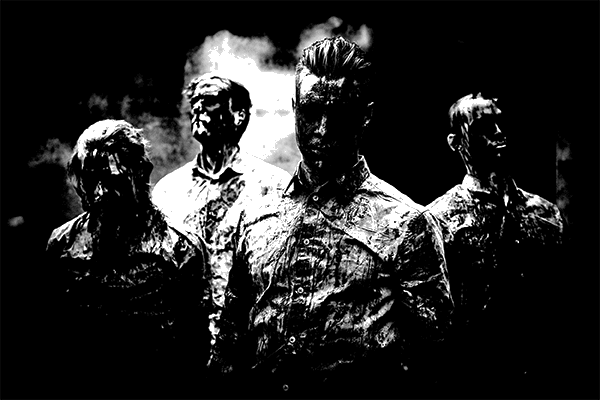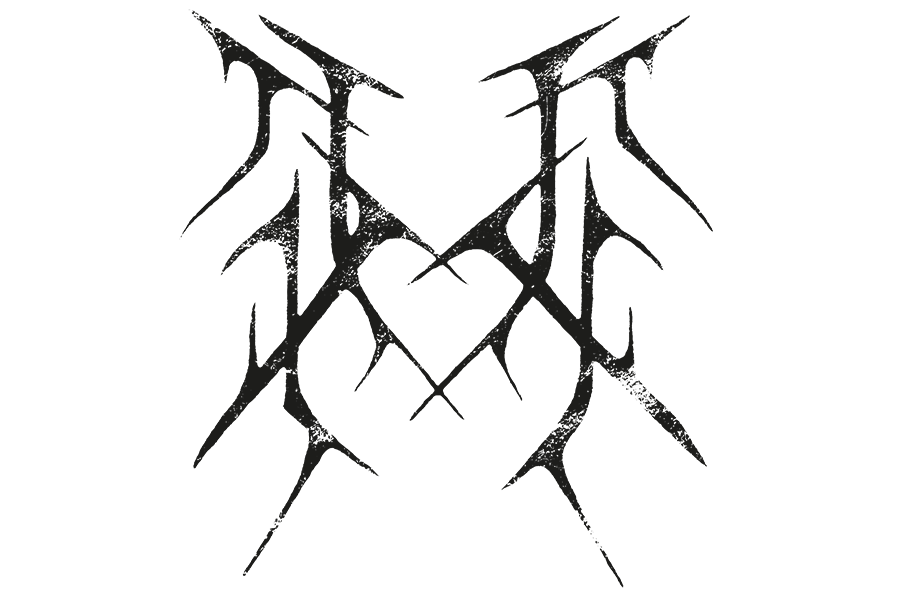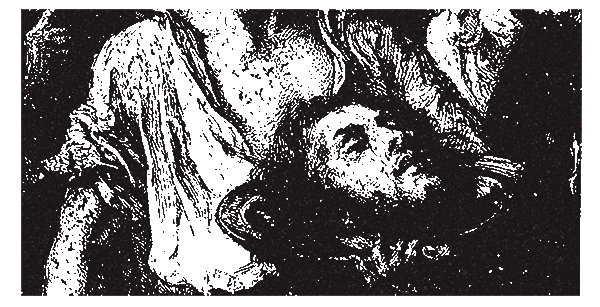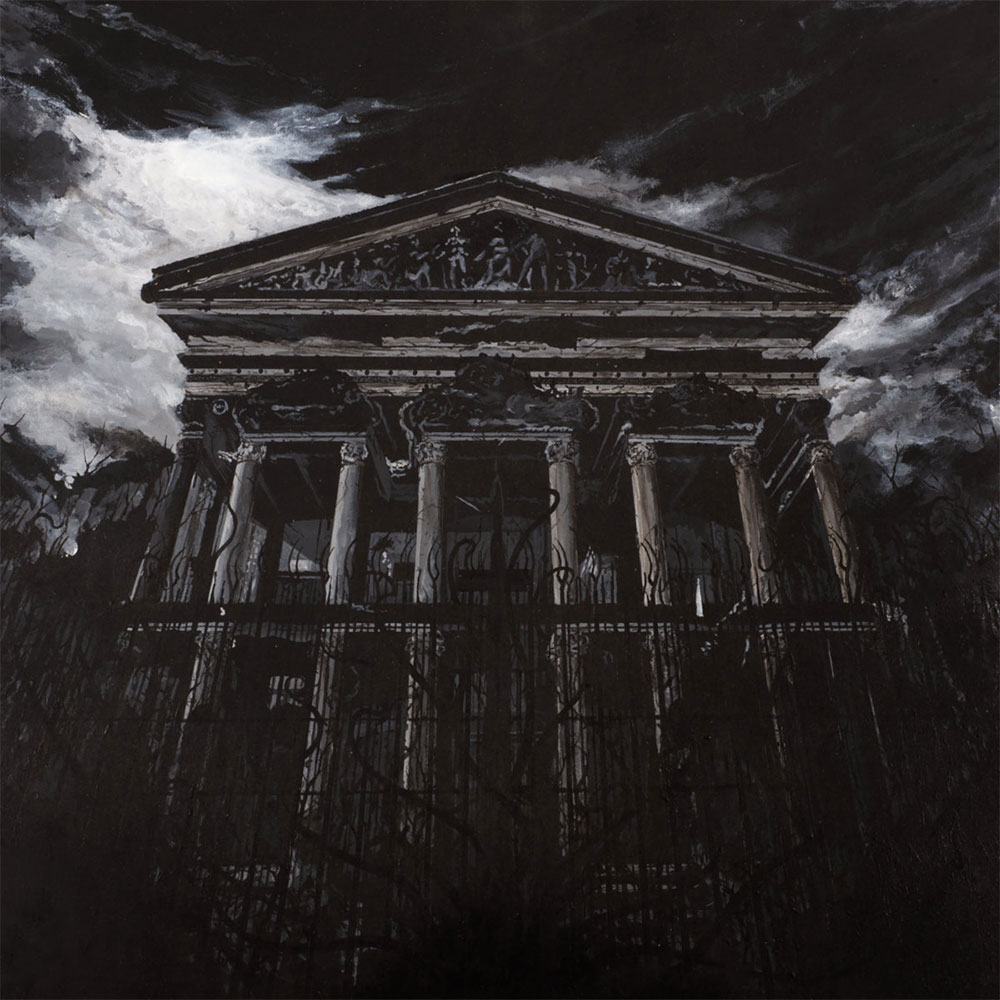Misþyrming
2022-12-15
by Niklas Göransson
With a hammer – D.G. of Icelandic black metal phenomenon Misþyrming discusses the musical and philosophical underpinnings of Með hamri. Includes an exclusive full album stream.
– I wanted to introduce some grit into both my song arrangements and the sound itself. As an ambitious musician, you should avoid treading paths you’ve grown too comfortable with; instead, always aim for new levels of extremity, depth, and epicness. More is more! And once you’ve attained greatness, it’s kind of dull to simply repeat it. This was our stated approach for the new record – to be daunting as fuck.
MISÞYRMING’s third album, “Með hamri”, is due for release by NoEvDia on December 16, 2022. Once again, it was both engineered and mixed by D.G. himself.
– As you know, we recorded “Algleymi” (2019) twice because our first attempt was an atrocity. The final version also has some minor issues, all of which come down to my limitations as a sound engineer at the time. It’s just like music composition – as long as you keep creating, you should be steadily improving. I’ve had a parallel journey with the engineering side of things; I’m trying to simultaneously develop both my writing and production skills.
Have you ever considered working with an external producer?
– Sure, I thought about it; but it’s been this way since the beginning, and I quite like how it flows. My song arrangements are getting better, as is the production, and I’d like to see how far I can take things. “Algleymi” was meant to be grandiose – very big and clean sounding – and I feel as if I accomplished that. This time around, I wanted a similar clarity but with some added grit.
There are many ways to achieve this, but distortion is D.G.’s main weapon of choice.
– I used some plugins on my reference track when I recorded the vocals, and it sounded very dirty. I’d try out a verse and then listen back to it with this nasty distortion; if I was satisfied with the take, I carried on. Once finished, I just rendered everything as it was – without changing a thing. I thought, ‘Yeah, it’s already filthy as fuck.’ So, I didn’t rely on fine-tuning any details but rather fell back on my arrogance and confidence in the fact that distortion works.
Is this an approach you came up with yourself?
– No, it was something that an old teacher of mine, Curver Thoroddsen – who is actually a pretty legendary producer and musician in Iceland – taught me. He always said, ‘When you’re mixing, make sure to put distortion on everything.’ Not everyone agrees with this guy’s aesthetic approach, he’s the odd one out, but I’ve carried it with me ever since.

After earning his degree in sound engineering, D.G. has produced and mixed a number of local projects such as SVARTIDAUÐI, MANNVEIRA, and ÖRMAGNA.
– Every year, I produce approximately two projects unconnected to my musical outlets, and then one with a band I’m a part of; I think that’s a good balance. Recording other bands – just seeing how the musicians adjust the settings on their amplifiers and so on – opens up new perspectives. For example: sometimes when a guitarist makes what I’d call a questionable decision for his amp settings, I’ve wanted to stop him and ask, ‘Dude, what are you doing? This makes no sense.’ But then I realise, ‘This is not my band, so it’s entirely up to them how their amplifiers should be tuned.’ So, I’ve learned not to interfere with that side of the production process.
Have you picked up anything useful?
– Mostly in terms of inspiration. Recently, I recorded this very noisy stoner doom band, PTHUMULHU; it was a long and gruelling session, and I came home exhausted. I was so fucking tired that I wanted to go straight to bed; instead, I picked up my guitar and played it for two hours. I wrote riffs for the first time in… several months, probably. I really surprised myself there because I didn’t think I had it in me – but being in a room with another band and seeing how they create their own atmosphere using whatever means they have at their disposal was extremely inspiring.
Do you always write alone?
– For MISÞYRMING, yes. I make instrumental demos that I can present to the guys, basically to make their jobs easier. Also, I think it gives everyone – myself included – a clearer vision of the final version before we start playing it together. I know that many bands write while jamming in the rehearsal space and then demo the song once it’s pretty much developed. I don’t want to present material to the rest of the band unless I’ve finished writing it, and that even includes the drums. And it really does matter: even minute details such as individual snare hits… should it be at a half-time speed or double-time? Should it be on the beat or offbeat?
Drumming offbeat means marking notes that are not ordinarily accented. In a 4/4 beat, the natural pulse – the rhythm one would instinctively tap or clap along to – is hitting the snare on one and three. Playing it on two and four is offbeat. Examples of both instances can be heard in the closing part of “Með svipur á lofti”, the second track on “Algleymi”: the drums begin on-beat and then switch to offbeat once the melody erupts.
– Every single drumbeat – right down to the fills – is well thought-out already at the demo stage. And this brings me to the predicament that I really don’t like instructing my very talented fellow musicians. Especially the drummers I’ve worked with in MISÞYRMING… I always hated having to tell them how to play their instrument. But at the same time, I hate other people’s input on my own art. I’m still trying to find a balance here; but don’t worry, there are several parts in my songs where I allow them to let loose. This happens during both the rehearsal and recording processes.
How much effort do you put into these demos?
– A lot. About half a year ago, Þórir (SINMARA, SVARTIDAUÐI) and I were drinking red wine – very sophisticated. As the wine filled our spirits, I had an idea: ‘Let me show you some demos of the new MISÞYRMING stuff.’ My drums were so perfectly programmed and everything properly mixed… really, far too ambitious for a simple demo, that Þórir asked me, ‘Why do you even bother working with all these musicians? Why not release those demos as the final product?’ It made me question it for a second, but deep down inside I knew it is the performance of M.S. – as with H.R.H. before him – that brings my songs to life.

“Með hamri” is the first record without MISÞYRMING’s original drummer, H.R.H. Two months before recordings started, D.G. brought in M.S. who played with SVARTIDAUÐI from the start until their recent demise.
– The drums are the spine of your song. So, if you use programmed drums, you’ll have a sterile, fixed, and very German-minded core; and in my opinion, that doesn’t work for most black metal. Of course, there’s a lot of excellent industrial black metal with programmed drums like, say, NEO INFERNO 262. That stuff is amazing– but my own preference is to do it with a real drummer, which promotes a more organic feel. And that’s the way to go for MISÞYRMING. If you can do it organically and still capture the sort of intensity where it’s loud and aggressive and fucking piercing, then you’re clearly onto something.
This was arguably accomplished with “Með hamri”; the album is full of the same raging energy that MISÞYRMING conjure up so effectively in concert. Given D.G.’s considerable stage experience, one would assume he has a decent idea about what song structures and dynamics work in a live setting.
– Funny you’d mention that because it’s often noticeable in bands that ‘make it’, so to speak; when they begin playing stadium shows, their songwriting tends to change. For example, they might introduce more singalong parts and ‘Hey, hey!’ choruses – which I don’t have big a problem with, but it’s often blatantly obvious that the material has been tailored for live performances. It’s possible that such thinking has affected me, but I doubt it. For comparison, I finished writing the last album in 2016 when MISÞYRMING had only been playing abroad for about a year.
“Algleymi”, was first recorded in late 2016; D.G. felt unconvinced by the final result and so began re-doing it from scratch the following year. Consequently, the material was already three years old upon its May 2019 release.
– We’ve now been touring actively for eight years and gained a lot of experience along the way, which has surely affected us in several ways. I’d say that we have adopted a kind of MANOWAR ethos for live performances. It also comes from watching concert DVDs; even basic classics like METALLICA’s “Seattle ‘89”, if you know that one? It’s their best, for sure. METALLICA playing for “For Whom the Bell Tolls” when they were young… damn, that’s some fucking magical spirit right there. Extremely potent: true metal. And whenever MISÞYRMING takes the stage, we bring out as much of that power as we can.
How does one incorporate this into a recording process?
– One approach is to not rely on a click track all the time. I’m usually against it, but – for various practical reasons – we do use a metronome sometimes. However, the opening track on “Með hamri” was supposed to be furious, so there was no question that we had to record it without a click. The song flows as if it was being played live, which really keeps the listener on edge: as if something is about to explode at any point. But having a lively drummer, that’s number one. And when you’re tracking guitars, they won’t sound loud unless you record them loud.
Unlike many modern bands, MISÞYRMING do not use digital preamps connected to a computer but rather record the old-school way – by micing up an actual guitar amp.
– We had to take great care not to damage our hearing during this process, but it truly felt as if we were being as toxic in our masculinity as humanly possible. Obviously, we weren’t getting boners over technical shit like pedals, effects, and so on – it was just an overdrive pedal with everything turned up on max and then the amplifiers on fucking eleven. And the feedback you can hear in some of the stops, it’s not altered at all. Like, it’s a natural part of the actual recording.
The best example of this can be found in the aforementioned opener.
– When the song comes to a quick stop – boom! – it immediately goes into this very loud, piercing feedback and then straight back to the riff. I’m really satisfied with how it turned out. That’s precisely what I wanted to capture, and such thinking also comes from performing live. Feedback is fucking vital in a concert setting; you shouldn’t let the last chord just fade out… well, except for ballads I suppose, hah! We don’t do stops or silences between songs unless we have some interlude or playback bullshit happening. If not, it’s just full feedback to keep the atmosphere intense until the next song starts. So, we recreate this mood in the studio.
MISÞYRMING are scheduled to tour Europe with RITUAL DEATH, KRINGA, and NUBIVAGANT in January 2023. They have previously, on separate occasions, toured with ONE TAIL ONE HEAD and DARVAZA – both of which are fronted by RITUAL DEATH mastermind Wraath. I’m wondering if MISÞYRMING has some manner of contractual touring clause mandating that he must come along in some capacity.
– Short answer: yes. I fucking love that fella. The first tour that MISÞYRMING ever did was in 2015 with MGŁA, ONE TAIL ONE HEAD, and KRINGA. It was put on by the same team as this upcoming tour, A Thousand Lost Civilizations, who also organised the one with DARVAZA. Back in 2015, Wraath took it upon himself to mentor me because we were total rookies, and it was far from his first tour. He showed me how to act like a rockstar, so to speak, haha! You know, even if that might make some people scoff, that’s how it is. I think he’s an absolute monster of a frontman.
One could certainly have worse instructors. ONE TAIL ONE HEAD garnered significant notoriety for their live shows without even having released an album. Their debut came out in 2018, around the same time as they disbanded.
– It was eye-opening for me to see that you can build such a solid reputation and gain an audience just by touring relentlessly, without relying on studio output. Wraath and I get along well and agree about many things, but we are still different on many levels. However, when it comes to the basic MANOWAR outlook – the true metal ethos – I think both of us are on the same page. Metal is supposed to be dirty, ruthless, and rude; that’s how we bonded to begin with.

Judging by the album’s promo text, the topic of ‘true metal’ is a core tenet of “Með hamri”.
– You know, I only discovered MANOWAR about two years ago. Somehow, they were totally off my radar. It was my bandmate Tómas who introduced me to this concept of applying MANOWAR values to your own life. Say you have a problem or something that’s bothering you, then you should always ask yourself: ‘Is this true metal?’ If the answer is no, then you can say, ‘Fuck it’ and just ignore it. Like, if somebody is condemning you or being hurtful and it’s not based on anything rational – fuck them. But if it’s constructive criticism in the spirit of true metal, then perhaps you should take it seriously. This might sound naïve on the surface, but I think there’s a certain beauty to its straight-to-the-point simplicity. There’s no need to complicate matters.
“Með hamri” gives the impression of being somewhat confrontational. However, the lyrics are riddled with cryptic metaphors, making it difficult to determine who the foes are and what battles are being waged.
– Hm, I’m not sure how much I want to reveal about the lyrical content. Basically, the fundamental issue is that I can’t write interesting lyrics unless I’m being authentic. If I’m frustrated or pissed off, that’s typically when I pick up a pen. I don’t want to write fantasy stories about mysterious caves that are super deep and lead to the void, blah, blah, blah. That’s kind of pretentious – or at least something I don’t find particularly compelling. I have no interest in pure fiction. The lyricists that impress me are the ones who write from their hearts, so that’s what I try to do. There’s a lot of wrath on this album, and it’s all genuine.
Whilst the lyrics are written and sung in Icelandic, there are English translations in the booklet.
– The problem is that I’m not sure my message is conveyed properly when our music reaches international markets, especially when it’s sarcasm that’s first been written down and then sung. You can’t always catch it. Sometimes when I come across as full of hatred, I’m just being a bit playful. A couple of songs on “Með hamri” are declarations of war: ‘I’m gonna fucking kill you!’ and so on. Parts of it come straight from me, but other times I’m singing from the perspective of someone else – as if to mock them. Like, ‘Look at you, all bark and no bite.’ And that’s the whole sarcasm about it. The lyrics portray all the vitriol coming from these really destructive, tragic individuals who are incapable of seeing their own behaviour. Actually, wait; I need to show you something.

D.G. rummages around the contents of his desk, then holds up an album: “Svik, harmur og dauði” by HAM.
– I brought out this CD before we started the interview, so I’d remember to mention it. HAM is a legendary Icelandic band. Their music is kind of like LAIBACH-influenced rock – quite slow, and very moody. A lot of people in the scene here want to call it black metal, but people outside the scene refuse to call it black metal. Their lyrics are oftentimes so weird that you might as well just disregard them as nonsense. The singer once said that nonsense is basically surrealism, and that’s what makes their lyrics art. This is Icelandic humour; I can’t make it sound funny with further explanation!
“Ingimar”, the final song on this particular album, is about a murder that happened back in the year 2010.
– These lyrics are so weird; they’re mostly sung in first-person perspective from the murderer’s point of view. Some guy is dating a woman that the murderer loves, so he’s jealous. He starts stalking and looking through the windows and being generally creepy until he eventually decides to get rid of the sole obstacle standing between him and the girl. And throughout the lyrics, you lose sense of the narrative because one of the last verses is sung from the victim’s perspective.
At this point in the tale, the victim is already dead – but his ghost has begun stalking the murderer.
– Now, his ghost is looking through the window and feeling jealous of the murderer who got the girl. Very confusing, and that’s sort of what I was going for with some of my lyrics. I’ve learned to enjoy the polarisation in today’s internet politics; it’s amusing to watch people argue because no one on either side is ever gonna willingly agree about anything. It’s just a competition to see who is more right – regardless of topic. So that’s kind of what I’m playing with, being on both sides of the argument. The artwork for “Með hamri” is supposed to portray this polarisation.
The “Með hamri” cover was painted by Manuel Tinnemans, who also supplied the artwork for “Algleymi”.
– The building and the fence in front of it show you that you cannot enter. That’s basically its sole function – to appear inhospitable and intimidating. And when the first song comes on, that’s precisely the mood you should get from the performance. It’s aggressive and unwelcoming; it’s above you. Very arrogant, but that’s the fucking point! Black metal should be arrogant.




